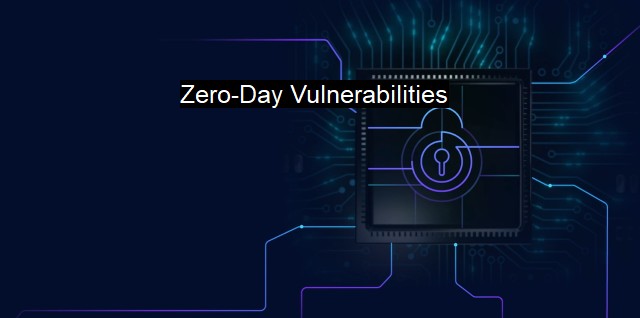What are Zero-Day Vulnerabilities?
Zero-Day Vulnerabilities: The Untouchable Threat to Software and Hardware Security
"Zero-day vulnerabilities" refer to a significant flaw or gap in software or hardware that is unknown to its author or vendor and is yet to be corrected, standing at the focal point of a frantic race to limit efficient exploitation of the gap by alleged attackers. These vulnerabilities are incredibly valuable for hackers or anyone planning to cause a security breach due to the immense potential they entail.In cybersecurity terms, "zero-day" refers to the fact that vendors learn about these vulnerabilities the same day they are utilized, implying that they have zero days in advance to fix or circumvent the system or software flaws. In an ideal world, a vulnerability is recognized during internal system checks, fixed before threat agents recognize and exploit it. Still, some risks fly below the radar, escaping detection before release – those are "zero-day" bugs or vulnerabilities.
A zero-day attack happens when a hacker identifies a never-before-seen vulnerability in software or hardware and exploits it before the developer or vendor is aware that their product has been compromised. Attacks can be pernicious, leading to stolen data, severe infrastructure damage, compromised systems, and beyond. By the time developers or vendors patch the vulnerability, significant damage would have already occurred.
It is easy to see why the zero-day vulnerability is frightening from a cybersecurity standpoint. Hackers can exploit it surreptitiously before a fix is released, causing significant damages that can take weeks, months, or even years to rectify. With the advent of cloud computing and the Internet of Things (IoT), along with increasing digital interconnectivity, the potential impact of zero-day vulnerabilities has escalated.
Regarding the link to antivirus software, it’s important to understand that such software runs on complex algorithms to identify potential threats based on their behavior and characteristics. they're often most efficient at detecting known threats as they rely on threat and malware databases. Thus, a fresh zero-day attack could easily bypass these traditional security measures as it exploits previously unknown vulnerabilities, and there are no recorded indicators of such attacks in these databases.
To be robust against zero-day vulnerabilities, cybersecurity strategies need to be proactive instead of reactive. Things like running regular vulnerability scans, conducting expansive threat hunting activities, and maintaining system softwares upgraded and patched can reduce the impact. more advanced security measures such as adopting behavior-based threat detection alongside traditional antivirus software, and employing machine learning techniques to recognize unusual actions can be beneficial.
Truthfully, there isn’t a failsafe solution to prevent zero-day attacks due to the nature of their unknown and unpredictable nature. Consequently, defensive strategies often involve a mix of prevention methods and post-incident response planning.
Zero-day vulnerabilities represent a significant threat in terms of cybersecurity. Given the astronomical rise in our reliance on digital technologies, the problem is poised to escalate further unless we redouble our preventative, detective, and correction cooperative efforts. The ways in which we tackle such vulnerabilities and enhance our protective measures against cyber threats will continue to evolve, accommodating the new realities of privacy, encryption, and increasingly refined hacking methods. Thus, it is important for private and public sector entities to invest strategically in cybersecurity.

Zero-Day Vulnerabilities FAQs
What is a zero-day vulnerability?
A zero-day vulnerability is a software security flaw that is unknown to the software vendor or antivirus vendor. This means that the vulnerability can be exploited by cyber attackers, who may use it to gain unauthorized access to systems, steal data or launch attacks.How do cyber attackers discover and exploit zero-day vulnerabilities?
Cyber attackers typically discover zero-day vulnerabilities by analyzing software code, reverse-engineering software, or using automated tools. Once a vulnerability is discovered, attackers can create malware that exploits the vulnerability and use it to infiltrate target systems.How can individuals and organizations protect themselves against zero-day vulnerabilities?
Protection against zero-day vulnerabilities requires a multi-layered approach. Installing security patches and updates as soon as they are released, keeping antivirus software up-to-date, and implementing strong access controls are all important measures. Additionally, using network segmentation, monitoring network traffic, and conducting regular security assessments can help organizations identify and mitigate vulnerabilities before they are exploited.Why are zero-day vulnerabilities so dangerous?
Zero-day vulnerabilities are particularly dangerous because they are unknown to software vendors and antivirus vendors, which means there is no patch available to fix the vulnerability. This makes it easier for cyber attackers to exploit the vulnerability for extended periods of time, potentially causing significant harm to individuals and businesses alike. Additionally, zero-day vulnerabilities can be sold on the black market to other attackers or used as part of larger cyber attack campaigns against specific targets.| | A | | | B | | | C | | | D | | | E | | | F | | | G | | | H | | | I | | | J | | | K | | | L | | | M | |
| | N | | | O | | | P | | | Q | | | R | | | S | | | T | | | U | | | V | | | W | | | X | | | Y | | | Z | |
| | 1 | | | 2 | | | 3 | | | 4 | | | 7 | | | 8 | | |||||||